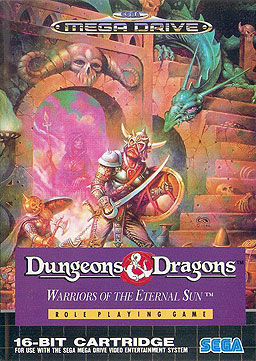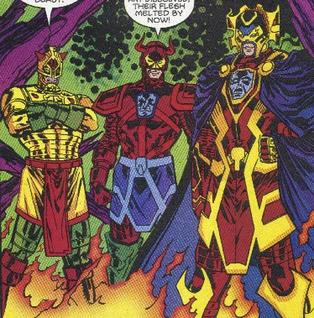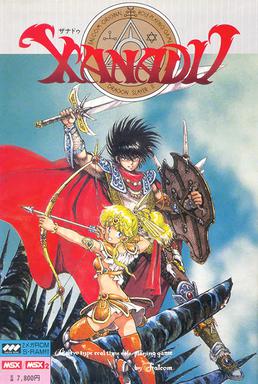The world of Legend
The world of Legend has noticeable parallels with Earth in the late 10th century AD, with strong elements of Christian, Greek, Roman, Norse and Arabian mythology. Crusaders of the 'True Faith' (an analogue of Christianity) have defeated the Ta'ashim people (an analogue of Islam) and conquered the Outremer. As the timeline approaches 1000 AD, Millennialist fever grips many.
After emerging victorious from the Battlepits of Krarth (book 1), where a deadly contest is held every thirteen months, you - a hero (or a group of heroes) belonging to the True Faith - are involved in a bloody battle against a pack of werewolves (book 2). Having defeated the pack, you receive a jeweled scabbard from a dying harpist - it's the scabbard of the Sword of Life, dubbed Blood Sword in popular folklore.
You will need to find the missing parts of the sword - first the hilt, then the blade - in order to slay the coming True Magi, who were killed in the Blasting - a major cataclysm - six hundred years ago, and now want to rule the world on their return. Only the Blood Sword, the bane of the undead, can stop them. So you travel to the northern land of Wyrd, where the Warlock-King guards the hilt from inside his Palace of Eternal Dusk. Then your journey takes you south (book 3), to Crescentium - the main port of the Outremer. There you will find several allies - among whom the assassin leader Hasan-i-Sabbah - who will help you find the blade. But your old enemy Aiken - a Yamatese warrior, known in the lands of the West by the name of Icon the Ungodly - will eventually find you, and after you defeat him for the second time Icon falls down to Sheol, the realm of the dead, taking the Blood Sword with him.
So you will have to enter Sheol (book 4), a patchwork of hells from different mythologies, where a mysterious man who goes by the name of the Traveller takes you through a long journey which ends before archangel Azrael. Here you discover that the Traveller is no one else but Icon, your arch-enemy, whom you finally manage to kill, thus retrieving the Blood Sword. In the last book, while the Millennialist fever is engulfing the continent, you travel north once more to enter the citadel of Spyte, where the True Magi are going to reincarnate at midnight at the end of the millennium. You finally defeat them with the help of Karunaz, a Ta'ashim noble warrior, son of Hasan-i-Sabbah. It's now midnight of Winter's Eve, 999 AD - Judgment Day has come, and you are rewarded with eternal life in Paradise.
Gameplay
The book series differed from many of the Fighting Fantasy and Choose Your Own Adventure type books of the era by being designed for multi-player, co-operative play (though there was also a single-player option, and one player could control more than one character at a time).
A party could consist of up to four players, with each player being either a Sage, Enchanter, Trickster or Warrior. Each of the classes was well-balanced and offered a different playing style from the others. Characters advanced in level, gaining power as the series progressed, and were carried forward from book to book, giving the experience of one long story.
Each player was autonomous - often paragraphs would be for one player's eyes only, and he would be privy to some information that he was free to withhold from the rest of his party.
Combat
Combat took place on mini-maps consisting of squares, with players able to use tactical combat options to defeat their foes. This added a dimension of realism to the game, for players had to move to their enemies before fighting them, and if it were a surprise attack, their enemies would start near or next to them. Some mini-maps include a square for fleeing; if the players wish to flee from the battle, they must move to that square before turning to the appropriate paragraph.
Sometimes there would be impassable obstacles on maps which characters would have to get around, or squares impassable to players but usable by monsters (e.g.: burning hot coals).
Classes
- Warrior: The typical hack-and-slash, honourable fighter. He can absorb and deal the most damage, but does not have any unique skills and must also act honourably or face penalties.
- Trickster: A cunning and charismatic thief, albeit one with a heart.
- Sage: A warrior-monk with mystical powers such as levitation and healing, as well as knowledge of ancient lore. There are many occasions when a Sage's wisdom is called upon to solve a problem or provide more information about something.
- Enchanter: A mage who starts the game with a long list of spells.
Attributes
- Fighting Prowess: A measure of how powerful a fighter the character is.
- Psychic Ability: An indicator of the character's resistance to attack spells and (in the case of an Enchanter) his or her aptitude for magic.
- Awareness: The character's speed, dexterity and cunning.
- Endurance: Measures the character's state of health; wounds are deducted from Endurance and if it reaches zero, the character dies.
Books in the series
The series consisted of five books:
1 : The Battlepits of Krarth "Every thirteen lunar months the Magi of Krarth hold a deadly contest to see which of them will rule that bleak and icy land. Teams of daring adventurers are sent down into the labyrinths that lie beneath the tundra, each searching for the Emblem of Victory that will win power for their patron. Only one team can survive. The others must die."
2 : The Kingdom of Wyrd "From the Palace of Eternal Dusk, the Warlock-King holds his realm in thrall. His tyrannized subjects live in perpetual fear, for they know their evil monarch can see into the minds of others and slay them in their dreams. Only outsiders from beyond the boundaries of Wyrd may slay the tyrant - and they will need all the courage and skill that mortals ever can possess."
3 : The Demon's Claw "Will you survive the perils of the desert city of Crescentium? The wandering ghouls and assassins? The half-human monsters? The dreaded Seven-in-One? For this is a land of sorcery and treachery - where you will encounter terrors and wonders more fabulous than you had ever dared imagine - the great Roc, the three wishes, the ship of the Pirate-King, the flying horse, the magic of the beautiful Psyche. And who shall win the Sword of Death, the Demon's Claw itself?"
4 : Doomwalk "Of all the desperate adventures, this is the most desperate - and the most vital. Only two years remain before the year 1000, when the Magi's power will have waxed full and the moment of their reincarnation will be at hand! All is not lost; if you can recover the fragments of the Blood Sword, the Magi can be opposed. But to do so, you must travel to the land of death..."
5: The Walls of Spyte "In the darkening sky above, five ominous stars have come into conjunction for the first time in 200 years. Out of the vault of the sky they cast their baleful influence across the frozen landscape. They are the disembodied spirits of the last of the Magi, seeing the return to the mortal world at midnight and ushering in a new era of terror. You wield the sole force in the world capable of destroying the Magi. The Sword of Life is mankind's only hope but it is no guarantee of victory. The Magi have had two centuries of exile to plan their reincarnation. To stop them you will need greater courage and strength than ever before!"
David John Morris is a British author of gamebooks, novels and comics and a designer of computer games and role-playing games.

The kampilan is a type of single-edged sword, traditionally used by various ethnic groups in the Philippine archipelago. It has a distinct profile, with the tapered blade being much broader and thinner at the point than at its base, sometimes with a protruding spikelet along the flat side of the tip. The design of the pommel varies between ethnic groups, but it usually depicts either a buaya (crocodile), a bakunawa, a kalaw (hornbill), or a kakatua (cockatoo)..

In mythology, legend or fiction, a magic sword is a sword with magical powers or other supernatural qualities. Renowned swords appear in the folklore of every nation that used swords.

Dragon Quest Swords: The Masked Queen and the Tower of Mirrors is a role-playing video game developed by Genius Sonority and 8ing and published by Square Enix for the Wii game console. The game is a spin-off from the Dragon Quest series, and was first released in Japan in July 2007, and worldwide the following year.

Dungeons & Dragons: Warriors of the Eternal Sun is a role-playing video game developed for the Sega Genesis in 1992 by Westwood Associates. The game tells the story of a party of adventurers who have been transported to an unknown world and must survive against its hostile inhabitants while learning about their new home and seeking allies. It is based on the Dungeons & Dragons (D&D) game rules, and uses creatures and themes from the D&D Hollow World campaign setting, such as Blacklore elves, the Azcans, beastmen, Malpheggi lizardmen, and dinosaurs.

The Foundling and Other Tales of Prydain is a collection of short high fantasy stories for children by Lloyd Alexander and illustrator Margot Zemach. The 1973 first edition includes six stories; the 1982 edition, eight. The 1999 edition adds a map of Prydain and a pronunciation guide . All are prequels to The Chronicles of Prydain, Alexander's award-winning series of five novels published 1964 to 1968.

The Enchanters Three are fictional characters appearing in American comic books published by Marvel Comics. The Enchanters Three first appear in Thor #143-144, and were created by Stan Lee and Jack Kirby.

White Knight Chronicles is a fantasy role-playing video game developed by Level-5 and Japan Studio and published by Sony Computer Entertainment for the PlayStation 3. It is Level-5's first project for the system. As of August 2009 it has sold 350,000 copies in Japan. A sequel titled White Knight Chronicles II was released in Japan in 2010. A related game for the PlayStation Portable, titled White Knight Chronicles: Origins was released in Japan, Europe and, Australia in 2011.

Dynasty Warriors Vol. 2 is a hack and slash video game, part of the widely popular Dynasty Warriors series, developed by Omega Force and published by Koei. The game was released exclusively on the PlayStation Portable.

Shadow Knights - The Shogun of Death, also known as Budo - The Art of Ninja Combat, is a platform game created by id Software and published by Softdisk in 1991. Shadow Knights was the first game created for Softdisk, who paid $5000 for it as part of id Software's contractual obligation to them. Shadow Knights was marketed by Softdisk as part of The Lost Game Collection of ID Software.
Deicide is the killing of a god. The concept may be used for any act of killing a god, including a life-death-rebirth deity who is killed and then resurrected.

Xanadu, also known as Xanadu: Dragon Slayer II, is an action role-playing game developed by Nihon Falcom and released in 1985 for the PC-8801, X1, PC-8001, PC-9801, FM-7 and MSX computers. Enhanced remakes were later released for the Sega Saturn, PC-9801 and Windows platforms. It is the second entry in the Dragon Slayer series, preceded by Dragon Slayer and followed by Dragon Slayer Jr: Romancia, which, as most games in the Dragon Slayer series, have very little relation with each other.
The Drona Parva, or the Book of Drona, is the seventh of eighteen books of the Indian epic Mahabharata. Drona Parva traditionally has 8 parts and 204 chapters. The critical edition of Drona Parva has 8 parts and 173 chapters.

Warriors: Legends of Troy, released in Japan as Troy Musou, is a video game for the PlayStation 3 and Xbox 360 games consoles set during the Trojan War. The game was developed by Koei Canada and is published by Tecmo Koei. While having a Warriors title, this game differs from the Dynasty Warriors series as it features a greater level of graphic violence. The game had a scheduled release date of Q4 2010 in all regions but was pushed back to Q1 2011 after Koei's announcement during Tokyo Game Show 2010.

Dragon Age: Origins is a story-driven role-playing game set in a world called Thedas, where the player usually assumes control of one primary character as the protagonist of the story. Throughout the course of the story, player characters in Origins are continually presented with choices for how to deal with major game events, and any decisions made usually influence the overarching narrative. While the player does retain control over forks in the narrative, the overarching narrative in each game follows a specified path, and the player's influence is confined to certain pre-ordained events in the game rather than the entire narrative itself.

Shadow Warrior is a first-person shooter game developed by Flying Wild Hog and published by Devolver Digital for Microsoft Windows, PlayStation 4, Xbox One, Linux and Mac OS X. It is a reboot of the 1997 game of the same name, developed by 3D Realms and published by GT Interactive, licensed out by Devolver Digital, featuring the same character Lo Wang and a modern era setting with Asian mythology elements, all of which were redesigned with modern, full 3D graphics and new gameplay features, while also being a throwback to classic first-person shooters. The game was released on 26 September 2013 through digital distribution via Steam and GOG.com with a later retail release. On 27 April 2015 the game was released for both OS X and Linux. Upon its release, the game was met with mixed reviews. A sequel, Shadow Warrior 2, was released in 2016; and another sequel, Shadow Warrior 3, was released in 2022.

Bloodborne is a 2015 action role-playing game developed by FromSoftware and published by Sony Computer Entertainment for the PlayStation 4. Bloodborne follows the player's character, a Hunter, through the decrepit Gothic, Victorian-era–inspired city of Yharnam, whose inhabitants are afflicted with a blood-borne disease which transforms the residents, called Yharnamites, into horrific beasts. Attempting to find the source of the plague, the player's character unravels the city's mysteries while fighting beasts and cosmic beings.

Doom Eternal is a first-person shooter game developed by id Software and published by Bethesda Softworks. The sequel to Doom (2016), and the seventh game in the Doom series, it was released for PlayStation 4, Stadia, Windows, and Xbox One on March 20, 2020, with a port for Nintendo Switch released on December 8, 2020, and versions for PlayStation 5 and Xbox Series X/S released on June 29, 2021.

Total War: Warhammer III is a turn-based strategy and real-time tactics video game developed by Creative Assembly and published by Sega. It is part of the Total War series, and the third to be set in Games Workshop's Warhammer Fantasy fictional universe. The game was announced on 3 February 2021 and was released on 17 February 2022. It received positive reviews from critics and was nominated for the British Academy Games Award for British Game at the 19th British Academy Games Awards.
















